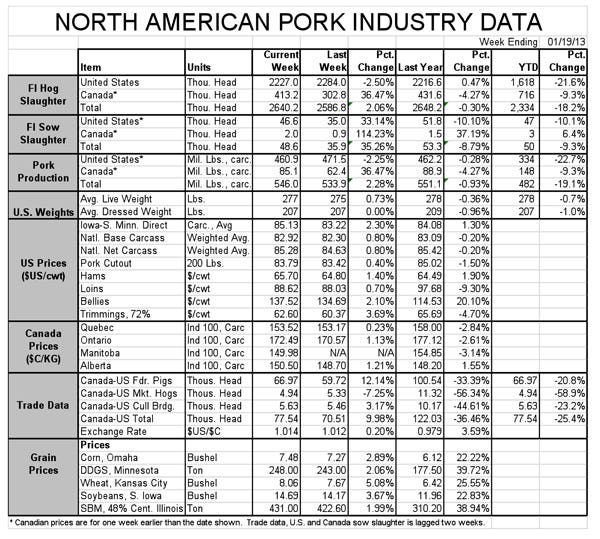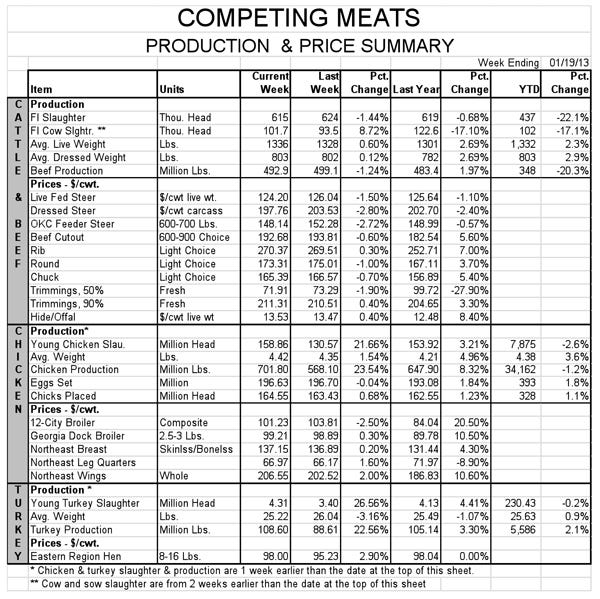Wholesale Pork Cuts Price Reporting Readied for Real Time
We are off and running with mandatory price reporting (MPR) for wholesale pork cuts!
January 22, 2013

We are off and running with mandatory price reporting (MPR) for wholesale pork cuts! The system went active on Jan. 7 and the data for that date were published on Jan. 14. Daily data delayed by one week have been published each day since. USDA plans to follow this one-week delay practice until Jan. 28, when all of the prior week’s daily data are published and the system goes active in “real time” – or as close to real time as it can get – with data published each day as it is received. More on that plan and some concerns I have about it later.
At present, there are four reports being published – a morning and afternoon report for prices FOB (free on board) Plant and FOB Omaha. The former shows actual prices at the plants reporting to the system. The latter adjusts those prices to an Omaha basis using transportation cost estimates provided by USDA. The FOB Omaha report would be, theoretically at least, the equivalent of the current voluntarily reported prices and is provided by USDA at the urging of the industry so market participants can observe the differences that may exist between the old and new systems with location held constant. The FOB Plant reports are numbered LM_PK600 and LM_PK602. The FOB Omaha reports are LM_PK601 and LM_PK603. They can all be found at http://www.ams.usda.gov/AMSv1.0/DelayedDailyPorkReports
The voluntary system will be continued for some period of time to allow market participants to compare the data generated by each system. Many contracts and pricing formulas are based on the prices reported in that voluntary pork report. The new report is expected to generate different prices than did the old one, meaning many of those arrangements will have to be altered and both buyers and sellers need some idea of how price levels may have changed.
Does that mean packers have not been reporting “true” prices under the old system? No, not at all. But there has always been an incentive to report the highest price possible, and the reporting was voluntary. Would hog producers do it any differently? Of course not.
The new report will include all prices, so the feeling is that the weighted averages of these prices will be lower than the old “top-of-market” prices. It's nothing sinister, in my opinion, just a different way of doing things.
The first reports were released Jan. 14 and differed greatly from what we have seen over the years from the voluntary system. Consider:
The afternoon mandatory report for Jan. 7 (released on Jan.14) included data for 552.8 loads of product. That compares to 91.5 loads on the voluntary report for that day. The 552.8 loads were more than was reported “weekly” for every week except two since January 2005.
The Jan. 7 afternoon mandatory report contained quotes for 114 pork cuts, while the voluntary report for that same day contained quotes for 24. The mandatory report, of course, contains far more cuts to start with as USDA lists 288 individual line items under regular pork cuts and another 48 for cuts with added ingredients. But 114 vs. 24 is a big gain in the number of prices published, and prices were reported for another 60 regular pork cuts and 13 added-ingredient cuts that could not be published due to confidentiality restrictions. Add those and that advantage goes to 192 vs. 24.
Perhaps the most noteworthy difference so far is that the “estimated” cutout values on the mandatory reports have been higher than those of the voluntary report. First, note my emphasis on the term “estimated.” USDA does not know the cutout values of carcasses moving through any given plant. In fact, plants and companies only know those “on average” since the weights of cuts coming from individual carcasses are not generally recorded. USDA simply uses the average prices reported for each cut and a set of average cut yields to estimate the cutout value. So, the value is determined by the prices and the yields.
Because we expected the average prices to be lower when all prices got reported, this higher cutout value is a bit of a surprise. A major reason for the surprise is that USDA is using a new, updated set of cut yields. Those yields were provided by packers during the MPR implementation. They are not part of mandatory reporting, but packers did agree during the rulemaking process to provide average cut yields annually. That is far more frequent than USDA has updated yields in the past and will result in a much more accurate, timely estimated cutout value for the industry.
Finally, there is some discussion regarding how long the one-week delayed reporting will continue. As mentioned, USDA says it will do that only through Jan. 28. Some participants – including producers and packers -- in the MRP-negotiated rulemaking process believe this is not long enough to observe the differences. Many feel USDA agreed to at least six months of parallel reporting and fear that publishing voluntary and mandatory at the same time will kill any incentive to report on the voluntary system.
Any transition is tricky and providing an overlap is ideal. I understand why it seems illogical to keep data on ice for a week when it appears to be much broader and more robust than what we have had. But an overlap is indeed needed and I hope the parties to this system can find a way to provide it for as long as possible.


About the Author(s)
You May Also Like





